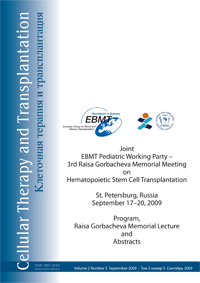Bone marrow angiogenesis is a prognostic value in patients with multiple myeloma undergoing high-dose therapy and autologous stem cell transplantation
Olga S. Pokrovskaya, Lidia S. Mendeleeva, Irina B. Kaplanskaya, Elena Yu. Varlamova, Elena N. Parovichnikova, Sergey M. Kulikov, Valeriy G. Savchenko
Research Center of Hematology, Moscow, Russia
Summary
Background
Angiogenesis plays an important role in hematological malignancies. An increase of angiogenesis – measured as bone marrow (BM) microvessel density (MVD) and as an increase in angiogenic factors – has been detected in patients with acute and chronic leukemia, myelodysplastic syndromes, and multiple myeloma (MM). Angiogenesis is a constant hallmark of multiple myeloma (MM) progression. It has also been reported that bone marrow angiogenesis is a predictive factor of poor survival in newly-diagnosed myeloma. The goal of our study was to investigate the dynamics of BM MVD in patients undergoing high-dose therapy (HDT) and autologous stem cell transplantation (ASCT).
Patients and methods
Our study included 36 patients (pts) with newly-diagnosed MM (22 in stage II and 14 in stage III according to Salmon and Durie) – 21 males and 15 females, median age – 51 ys (range 31–67). IgG MM was diagnosed in 18 cases, IgA MM in 6 cases, IgD MM in 1 case, light chain MM in 9 cases, and nonsecretory MM in 2 cases. All patients underwent HDT that included 3–4 cycles of induction therapy (VAD), stem cell mobilization with cyclophosphamide 6 g/m2 and G-CSF 5 mcg/kg, EDAP, and 1 or 2 ASCT with melphalan 200 mg/m2. The bone marrow biopsies for histological and immunohistochemical analysis were performed at the time of diagnosis, after the induction, after stem cell mobilization, before the 1st ASCT and after the end of therapy (5 times during the treatment). The control group was constituted by the healthy donors of BM, (7 male and 3 female, median age 29, age range 17–59). In healthy donors BM biopsy was performed during BM harvesting for allo-BMT. Blood vessels were highlighted by immunostaining of endothelial cells with a monoclonal antibody to CD34 (Novocastra Lab Ltd). The MVD was calculated in 10 fields of view using a 40x objective and 16x ocular lens.
Results
At diagnosis in all MM pts MVD was extremely high compared to healthy donors (152±8 vs 74±4). A significant decrease of BM MVD under each phase of therapy was registered: after the induction therapy MVD was 124±6, before the 1st ASCT – 109±5, and at the end of treatment – 97±3. There was a statistically significant increase of MVD after stem cell mobilization due to G-CSF (143±4). Despite the evident decrease of BM MVD in pts with CR or VGPR, it stayed, nevertheless, significantly higher compared with the control group (p<0,001).
The analysis of probability of CR or VGPR duration after ASCT – according to MVD at different phases of therapy – showed that MVD at diagnosis and before the 1st ASCT are important prognostic factors. The probability of duration of CR or VGPR was 63% in the group with low MVD before the 1st ASCT compared with 15% in the group with high MVD (p<0.02). MVD was revealed to be a more powerful prognostic factor for progression free survival (PFS) than CR or VGPR achievement.
We found a good relationship between BM MVD and the MM stage (p<0.05). The correlation between BM angiogenesis and albumin levels – as with β2-microglobulin levels – was not significant. There was no correlation between BM MVD before chemotherapy and plasma cell infiltration in these patients.
Conclusion
BM angiogenesis highly increased in patients with MM. Our data demonstrates a highly significant decrease in BM MVD in patients who achieved remission after HDT. But even after the end of HDT and ASCT, MVD is higher than in the control group. There is a statistically significant increase of MVD after stem cell mobilization with cyclophosphamide and G-CSF. MVD at the time of diagnosis and before the 1st ASCT are important prognostic factors for overall survival and PFS after ASCT. MVD before the 1st ASCT seems to be a more powerful prognostic factor for PFS than remission rate.
Our results reveal the decrease of MVD to be a powerful prognostic parameter for PFS in pts with MM, and they underscore the importance of angiogenesis in this disease.
Keywords
angiogenesis, multiple myeloma, autologous stem cell transplantation, microvessel density


